Questions to answer:
- How would someone try to get a list of names for a photo like this? Read the rest of this entry »
Nov 22
Posted by Anthony D Paul in Photos, Prior to Battle, Soldiers | No Comments
Oct 11
Posted by Anthony D Paul in After the Battle, Photos, Ships, Stories | 1 Comment
On October 10th, 1997, Rhea sunk due to a rotted hull and was left sunk for a month before being raised on November 11th to be scrapped.
Below is the local newspaper article (and transcription) from the next day (October 11th), provided by post-war cadet, Charles “Chuck” Donaldson.
WWII ship takes plunge
MESSY SPILL… Oshawa marine rescue personnel work to clean up diesel oil that was leaking from the MV Rhea after the ship sank yesterday morning in Oshawa harbor.
Former U.S. navy mine sweeper sinks in Oshawa harbor
By BRAD HONYWILL
Toronto SunOSHAWA—A mine sweeper that led U.S. military forces into Tokyo harbor at the end of World War II sits on the bottom of Oshawa harbor today after a mysterious sinking.
The MV Rhea—a 136-foot-long mine sweeper converted into a home—sank in about seven metres of water yesterday while tied to the Oshawa dock that has been its home for the past decade.
Harbormaster Donna Taylor said the ship appeared fine during a visual inspection at 10 a.m. but, 10 minutes later, it was sinking rapidly.
Phil Murphy, a tenant on the ship, had left for work when it went down. But it’s assumed that his cat was trapped in their cabin and unable to escape, Taylor said.
Taylor said emergency personnel from COMRA (City of Oshawa Marine Rescue Association) were immediately on the scene and prevented an estimate 1,600 litres of diesel oil from escaping into the harbor. The harbormaster said the former U.S. navy ship also saw action in the Korean War after World War II.
Later it was used as a training vessel.
The Rhea is owned by Gary Zulauf of Oshawa, who was away on a camping trip and had not been reached yet by authorities.
Taylor said that, although the Rhea was being used as a home, it was in the process of being restored as an operational [boat?]
Sep 7
Posted by Anthony D Paul in During Battle, Letters, Soldiers, Timeline | No Comments
After the surrender and occupation of Japan, the veil of censorship was lifted and the soldiers were then allowed to write freely to their families. Early messages were filled with assurances that everything is fine and that morale is high, despite missing home. These letters tell a different story and express the need for venting after over half-a-year of daily battle.
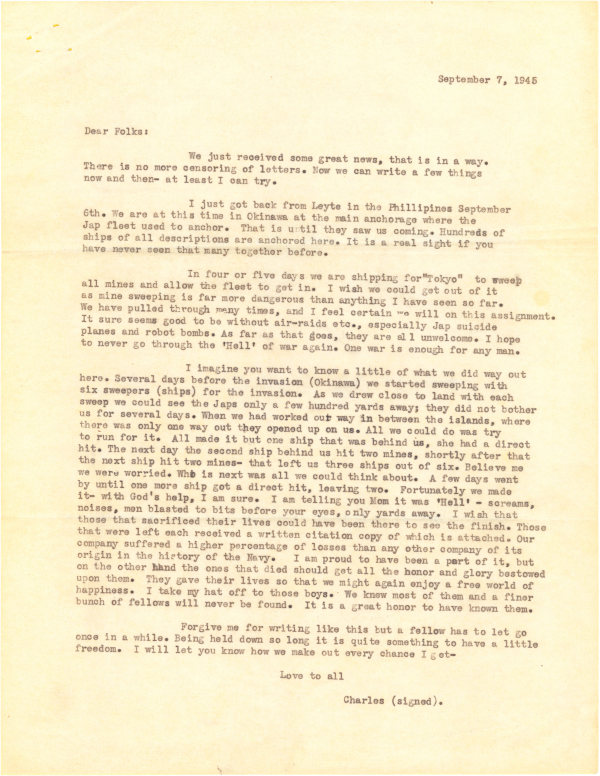
September 7, 1945; Letter to Home, from Chuck
Apr 25
Posted by Anthony D Paul in Documents, During Battle, Ships, Soldiers, Stories, Timeline, YMS-103 | No Comments
I got this action report from Richard Thornton, son of the captain who drafted it. It details the events leading up to the the beaching of YMS-103 in the first month of the Okinawa operations. You’ll see YMS-299 was in the same detail. My grandfather discusses these events in his journal as well.
Mar 21
Posted by Anthony D Paul in Documents, During Battle, Ships, Soldiers, YMS-103 | 1 Comment
Also via Richard Thornton, this is the first page of the YMS-103 muster roll. I don’t have the equivalent of this for YMS-299 yet, though I was curious what the document looked like.
Dec 17
Posted by Anthony D Paul in Letters, Prior to Battle, Soldiers | No Comments
Dec 10
Posted by Anthony D Paul in Letters, Prior to Battle, Soldiers | No Comments
Dec 5
Posted by Anthony D Paul in Letters, Prior to Battle, Soldiers | No Comments
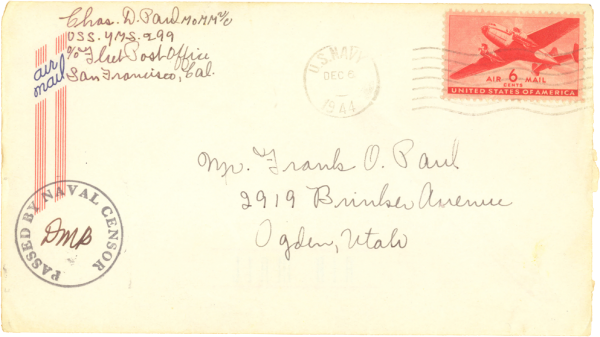
Envelope (front); December 5, 1944
Nov 19
Posted by Anthony D Paul in Letters, Prior to Battle, Soldiers | No Comments
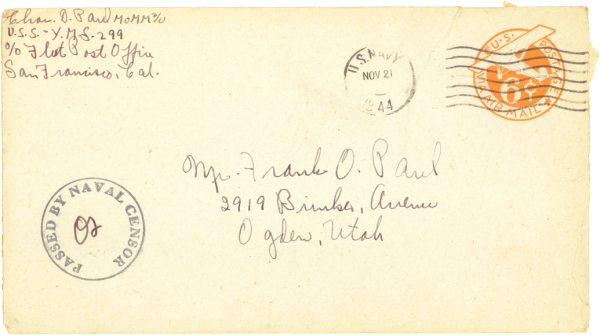
Envelope (front); November 19, 1944
Nov 12
Posted by Anthony D Paul in Letters, Prior to Battle, Soldiers | No Comments
Well, this is exciting! This is the first letter postmarked from the YMS-299.
The stomach problems have returned, that are presumably a mixture of butterflies for war and seasickness. He is tired of water and yearning for the land in back in Utah.
Ending this letter, he talks about laundry by brush. They never did get a washing machine. There isn’t room for it on such a small ship. I have an audio interview that I’ll post when I can, where he discusses the process and humor in laundry. They would tow their clothes on a line in the water to wash them, then lay them out to dry. They collected so much salt in them that they would become stiff and crispy, making velcro-like sounds when you moved in a freshly “cleaned” pair.
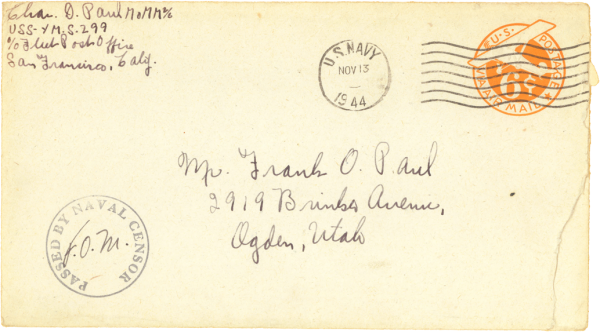
Envelope (front); November 12, 1944
Nov 7
Posted by Anthony D Paul in Documents, During Battle, War Context | No Comments
This is the citation mentioned in Chuck’s September letter home, commending the troops for their efforts in kicking off Operation Iceberg, the invasion of Okinawa during early April, 1945. This letter was given to all members of the YMS-299 crew (I have a second copy of it addressed to Thomas Morley, sent to me by his son).
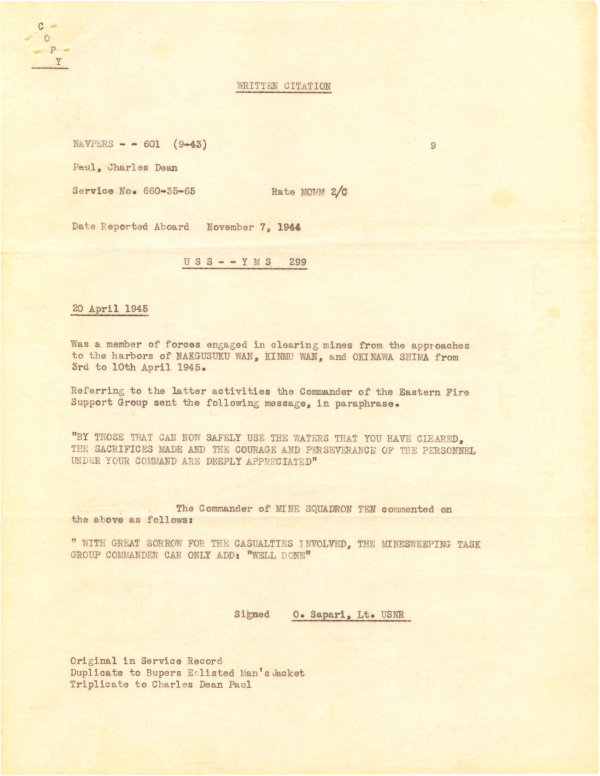
042045 Written Citation
Nov 6
Posted by Anthony D Paul in Letters, Prior to Battle, Soldiers | No Comments
Chuck mentions news about “the islands” that he is in. I am assuming he is referring to Hawaii, as he hasn’t shipped to the war yet and the post office is still in California.
The ship he is referring to likely wouldn’t be his own ship, but the USS Signet (AM-302). The Signet is, I believe, the transport ship he is going to take into the war. I’m guessing the crew and supplies on the YMS itself would need to be as trim as possible to make the long journey quickly and with fuel efficiency.

Envelope (front); November 6, 1944
Oct 24
Posted by Anthony D Paul in Letters, Prior to Battle, Soldiers | No Comments
This letter has one of my favorite bits of artwork of all of his stationery. The disc behind the hula girl is a tropical scene a bit hard to make out. The right is a trunk of a palm tree, with some leaves coming from the top. I am not sure what is in her hands, but I’m guessing it is some sort of rattle/instrument. It appears to be made of coconut shells.
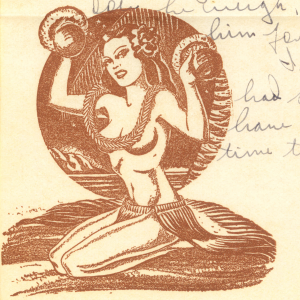
Stationery artwork; October 24, 1944
He mentions some love interests. Neither are anyone he ever married, so I don’t have backstory on them.
Also interesting, he acknowledges that he is not allowed to keep a wartime journal. This was common on both sides because picking journals off of the enemy could give intelligence on movements and strategy. Of course, he kept a journal anyway. Keeping a journal would have been a religious conviction (Mormons are urged to keep journals for posterity), but it is out of character for Chuck to break the rules, so I’d be curious what swayed his decision to keep the journal anyway.
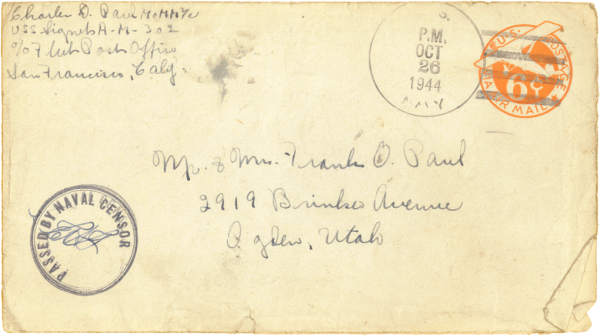
Envelope (front); October 24, 1944
Sep 27
Posted by Anthony D Paul in Letters, Prior to Battle, Soldiers | No Comments
Note the “see code” reference. It looks like Frank’s handwriting. Again, I haven’t attempted decoding any of the letters yet.
In this letter, Chuck is already thinking about what he wants to do after the war he hasn’t even been in yet. He mentions drumming. Playing in a jazz band was something he enjoyed through his life, actually playing weekly until his death in his 80s. He never worked on rail, as he mentions. I’m not sure what he did immediately post-war, but the bulk of the work he talked about was at the Coors canning plant.
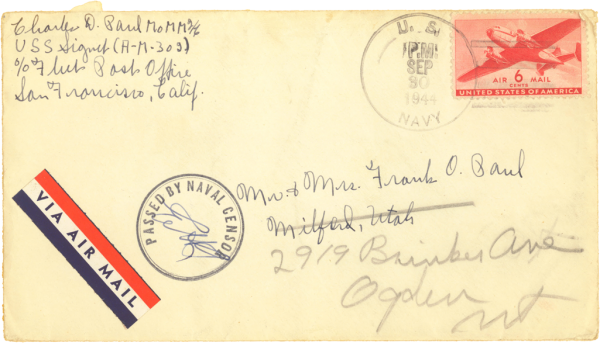
Envelope (front); September 27, 1944
Sep 8
Posted by Anthony D Paul in Letters, Prior to Battle, Soldiers | No Comments
It is peculiar how the postal system worked at this time. There are several addresses crossed out and rewritten, along with the associated stamps that let you know the envelope actually went through each of these relays before making it to their recipient.
There are some fun terms in this letter as well. I translated “cow’s age” but didn’t find any definition online for it. Both “cow’s age” and “crow’s age” seem to be used in extreme rarity and I couldn’t figure out a better translation, thinking it possible that neither of those is what is written. If you know it is another saying, please let me know. Otherwise, it sure looks like “cow’s age”.
“Fishful” is another odd term, meaning something is abounding with fish and usually used as an adjective. CDP uses it as a noun in this situation, meaning he is taking some liberties with the word and using it as a measurement for a lot.
Keep in mind CDP was as close to a farm boy as you can be, without actually working on a farm. His family was in the West, where much of the area was still pretty close to wild, even in the last century. Idaho and Utah, even now, are not dominantly suburban. His letters and journal are littered with misspellings for words we might find mundane. One that keep tricking me is his use of “kneed”, actually being “need”…presumably hyper-correcting for “know”.
In addition to mundane words, when we get into the journal and the later war letters, all of the military terminologies and names of Japanese locales are spelled incorrectly. This was commonplace amongst soldiers, many of whom knew nothing of the Orient prior to being shipped out. Due to secrecy of the situation, soldiers would likely have never seen the names of targets or military terms written or printed on anything, left solely to translate phonetically.
You can see the censor has been tightening down. There are multiple references in this letter to wanting to say more, but being bound not to.
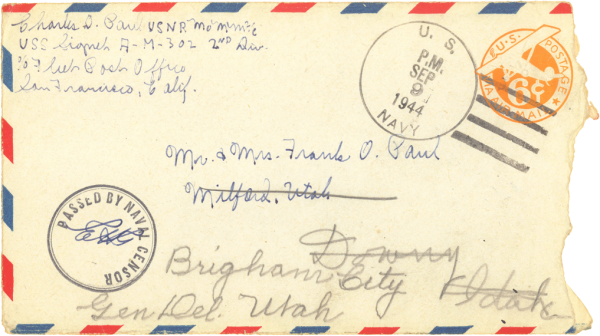
Envelope (front); September 8, 1944
You are currently browsing the archives for the Subject Matter category.
All content copyright © 2008–2026 Anthony D. Paul
Arclite theme by digitalnature | powered by WordPress